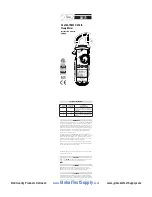
FEATURES
• True RMS
• 600A AC
• 750V AC/600V DC
• Resistance 60MΩ
• Capacitance 2000µF
• Temperature -31˚ to 752˚F (-35˚ to 400˚C)
• DC Microamps 2000µA
• Frequency/Duty Cycle
• Data hold
• Min/Max (25 ms fast capture)
• Manual ranging option
GENERAL SPECIFICATIONS
• Operating Temperature:
32
°
to 104
°
F (0
°
to 40
°
C)
• Storage Temperature
14
°
to 122
°
F (-10
°
to 50
°
C)
• Operating Humidity:
<75%
• Operating Altitude:
6,562 ft. (2000m)
• Pollution Degree:
2
• Display:
3 5/6" Digits 6,000 Count
• Backlight:
Yes
• Refresh Rate:
3/sec
• Over-range:
“OL” is displayed
• Dimensions:
8.75” X 3.5” X 1.75”
• Item Weight:
0.65 lb
• Calibration:
Recommended Annually
• CAT Rating:
CAT IV 600V / CAT III 1000V
• Certifications:
cETLus 3rd Edition,
CATIII 1000V, IEC 61010-1, 61010-2-032,
61010-2-033,
CSA C22.2, NO. 61010-1, 61010-2-032,
61010-2-033, 6’ Drop Protection, RoHS Compliant,
CE Conformity
• Battery Type:
(AAA) X 2
• Test Leads:
Test lead w/Alligator Clips
• Accuracy:
± (% of r # of least significant digits)
IMPORTANT SAFETY WARNINGS
WARNING
Read entire Safety Notes section regarding potential hazards and proper
instructions before using this meter. In this manual the word “
WARNING
” is
used to indicate conditions or actions that may pose physical hazards to the
user. The word “
CAUTION
” is used to indicate conditions or actions that may
damage this instrument.
WARNING
To ensure safe operation and service of the tester, follow these instructions.
Failure to observe these warnings can result in severe injury or death.
WARNING
• Before each use, verify meter operation by measuring a known voltage
or current.
• Never use the meter on a circuit with voltages that exceed the category
based rating of this meter.
• Do not use this meter during electrical storms or in wet weather.
• Do not use the meter or test leads if they appear damaged.
• Ensure meter leads are fully seated and keep fingers away from the
metal probe contact when making measurements. Always grip the leads
behind the finger guards molded into the probe.
• Do not open the meter to replace batteries while the probes are
connected.
• Use caution when working with voltages above 60V DC or 25V AC RMS.
Such voltages pose shock hazards.
• To avoid false readings that can lead to electrical shock, replace
batteries if a low battery indicator appears.
• Unless measuring voltage or current, shut off and lockout power before
measuring resistance or capacitance.
• Always adhere to national and local safety codes. Use proper personal
protective equipment (PPE) to prevent shock and arc blast injury where
hazardous live conductors are exposed.
• Always turn off power to a circuit or assembly under test before cutting,
unsoldering or breaking the current path. Even small amounts of current
can be dangerous.
• Always disconnect the live test lead before disconnecting the common
test lead from the circuit.
• In the event of electrical shock, ALWAYS bring the victim to the
emergency room for evaluation, regardless of victim’s apparent recovery.
Electrical shock can cause unstable heart rhythms that may need
medical attention.
• If any of the following occur during testing, turn off the power source to
the circuit being tested: arching, flame, smoke, extreme heat, smell of
burning materials or discoloration or melting of components.
WARNING
Higher voltages and currents require greater awareness of physical safety
hazards. Before connecting the test leads, turn off power to the circuit under
test, set meter to the desired function and range, connect the test leads to
the meter first, then connect to the circuit under test. Reapply power. If an
erroneous reading is observed, disconnect power immediately and recheck all
settings and connections.
WARNING
This meter is designed for trade professionals who are familiar with the
hazards of their trade. Observe all recommended safety procedures that
include proper lock-out utilization and use of personal protective equipment
that includes safety glasses, gloves and flame resistant clothing.
SYMBOLS
AC (Alternating current)
DC (Direct current)
Negative DC
AC/DC Voltage
Auto-ranging
Overload: Range Exceeded
Auto power off Active
Low Battery
Non-Contact Voltage
Minimum measured value
displayed
Hold/Capture Value
Duty Cycle
Maximum measured value
displayed
Voltage
Hertz/Frequency
Ohms/Resistance
Amperage
Capacitance mode in
nanofarads or microfarads
Diode
Degrees Celsius
Degrees Fahrenheit
Continuity
High Voltage Indication
Milli (x10
-3
or 0.001)
Mega (x10
6
or 1,000,000)
Nano (x10
-9
or 0.000000001)
Kilo (x10
3
or 1,000)
Warning or Caution
Micro (x10
-6
or 0.000001)
Dangerous Levels
Ground
Safe for disconnect from live
conductors
Double Insulation (Protection
to Class II)
• Backlight
• Worklight
• Audible voltage indicator
• Low battery indicator
• Auto power off
• Test lead storage
• Overmolded grip
• Magnetic mount
• Battery compartment latches
www.
GlobalTestSupply
.com
Find Quality Products Online at:
























